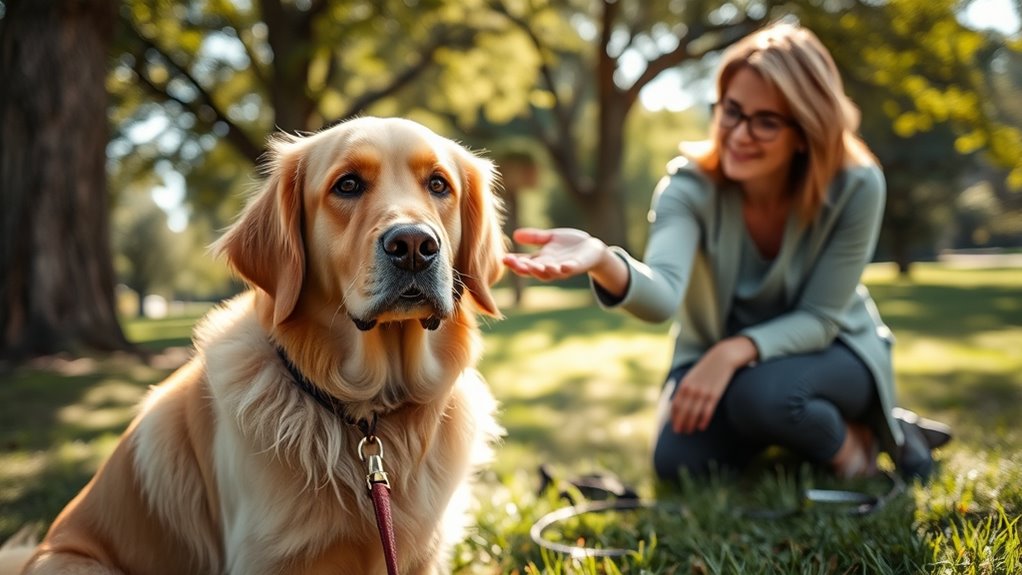Dominance myths in dog training are rooted in outdated concepts that misinterpret canine social behavior. Modern science shows dogs thrive on cooperation, not hierarchy. Methods like alpha rolls can create fear and erode trust between you and your dog. Instead, focusing on positive reinforcement and mutual respect fosters a strong bond and effective learning. Understanding these principles can transform your training approach and enhance your relationship with your pet. Discover more about effective, compassionate strategies next.
Key Takeaways
- Dominance concepts in dog training, like “alpha rolls,” are outdated and do not accurately reflect modern understanding of canine behavior.
- Forceful techniques can instill fear, leading to anxiety and potential aggression in dogs, damaging the trust between pet and owner.
- Dogs thrive on cooperation and positive reinforcement, rather than a rigid pack hierarchy; they see humans as partners, not rivals.
- The misconception of pack mentality misapplies wild dog behavior to domestic dogs, which do not constantly vie for leadership.
- Effective training focuses on mutual respect and trust, using rewards and interactive methods to motivate and enhance the learning experience.

While it might be tempting to think of dog training through the lens of dominance, this approach can be misleading and counterproductive. Many trainers have relied on outdated theories, like the idea of “alpha rolls,” which suggest that you need to assert your dominance over your dog to establish control. This method promotes a notion of a rigid pack mentality, where you and your dog are constantly vying for leadership. However, recent research indicates that this perspective doesn’t accurately reflect how dogs interact with each other or with humans.
You might believe that using forceful techniques like alpha rolls will help you train your dog, but what you’ll often find is that it can lead to fear, anxiety, and even aggression. Instead of fostering a trusting relationship, these methods can create a rift between you and your pet. Dogs are social animals that thrive on cooperation and positivity, not intimidation. When you focus on dominance, you miss the chance to build a bond based on mutual respect and understanding.
Using forceful training techniques can breed fear and anxiety in dogs, damaging the bond of trust between you and your pet.
Think about it this way: your dog doesn’t view you as a rival in a pack hierarchy. Instead, they see you as a companion and leader in their daily life. They’re more likely to respond positively to training methods that incorporate rewards and encouragement rather than fear and submission. By using positive reinforcement techniques, such as treats or praise, you can motivate your dog to learn new behaviors while strengthening your relationship.
Moreover, the concept of pack mentality is often misapplied to domestic dogs. In the wild, dogs form flexible social groups that adapt to their environment and circumstances. Your home isn’t a wolf pack, and your dog isn’t constantly plotting to overtake your position. Understanding this can help you train more effectively and compassionately.
Instead of trying to dominate your dog, focus on being a guide. Engage in training sessions that are fun and interactive. This not only helps your dog learn but also creates a joyful atmosphere where they feel safe and secure. Remember, training is a partnership. You’re not just teaching commands; you’re building a lifelong bond that enriches both your lives. By moving away from dominance-based theories, you’ll find that your dog becomes more enthusiastic to learn and grow with you. Embrace this shift, and you’ll see the benefits in your dog’s behavior and your relationship. Additionally, fostering a trusting relationship with your dog is essential for successful training outcomes.
Frequently Asked Questions
Can Dominance Training Harm My Dog’s Behavior Long-Term?
Yes, dominance training can harm your dog’s behavior long-term. When you rely on hierarchy misconceptions, you might unintentionally create fear or anxiety in your dog. This can lead to behavioral repercussions such as aggression or withdrawal. Instead of focusing on dominance, building a trusting relationship through positive reinforcement fosters better behavior and strengthens your bond. Remember, a happy and confident dog is more likely to respond positively to training and social situations.
What Are Positive Reinforcement Techniques for Dog Training?
Positive reinforcement techniques for dog training include clicker training and reward systems. You can use a clicker to mark desired behaviors immediately, followed by a treat or praise. This helps your dog associate good behavior with positive outcomes. Establishing a consistent reward system encourages your dog to repeat those behaviors. Focus on timing and clarity to reinforce learning effectively, and you’ll see great improvements in your dog’s responsiveness and overall behavior.
How Can I Build Trust With My Dog?
To build trust with your dog, focus on relationship building through consistent routines. Spend quality time together, engaging in activities like walks or playtime. Use positive reinforcement to reward good behavior, which helps your dog feel secure. Establishing a predictable schedule for feeding, training, and exercise reinforces trust. Always be patient and gentle, allowing your dog to feel safe and understood. This way, you’ll strengthen your bond and create a lasting partnership.
Are There Specific Breeds More Prone to Dominance Issues?
Certain breeds can exhibit tendencies toward dominance, but it’s more about individual temperament factors than the breed alone. Have you ever met a dog that seemed to rule the roost? Breeds like Rottweilers and Doberman Pinschers might show stronger dominance traits, but socialization and training play huge roles. It’s essential to understand your dog’s unique personality and provide the right guidance, regardless of their breed, to foster a balanced relationship.
How Do I Recognize Signs of Anxiety in My Dog?
You can recognize signs of anxiety in your dog by observing their body language and vocal cues. Look for a tucked tail, flattened ears, or excessive panting, which indicate stress. Your dog might also pace, hide, or avoid eye contact. Pay attention to changes in their usual bark or whine, as these sounds can signal discomfort. By understanding these signs, you can help your dog feel more relaxed and secure in their environment.
Conclusion
In the world of dog training, the notion of dominance is a mirage—an illusion that misleads us. Science teaches us that understanding and communication, rather than power struggles, forge stronger bonds with our furry companions. Embrace positive reinforcement as your guiding light, and watch your relationship blossom like a well-tended garden. By casting aside outdated myths, you’ll discover that love and trust lead the way to a harmonious partnership with your canine friend.









